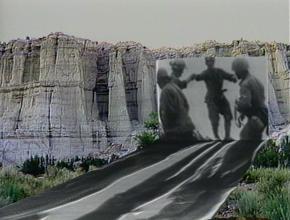Vašulka Mediascape
Woody Vašulka, Art of Memory (1987, 36:00)
“There were three major sources of inspiration for the tape – Vašulka’s childhood memories of newsreels of world conflict; historian Frances Yates’s book The Art of Memory and the engravings of the 19th century Romantic illustrator Gustave Dore. Vašulka took from Yates not only the title of his videotape but also one of the tape’s two organizing principles, that of ‘putting thoughts into a landscape.’ Yates writes in The Art of Memory about mnemonic devices used by classical Greeks and Romans. In preparation for his long orations, Cicero would walk through a temple noting the number and positions of the columns, assigning to each column one of the topics of his speech. By visualizing his temple walk when he debated, he could recall the points of his speech with a perfection that left his opponents defenseless.”
Gene Youngblood, “Video by Steina & Woody Vašulka,” catalog, Denver Art Museum, Denver (1992); link: https://monoskop.org/images/d/db/Steina_and_Woody_Vasulka_Denver_Art_Museum_1992.pdf.
Woody: “Of course, I foresee the possibility, even in my work, of identifying a western landscape as a set of algorithms, because it has a finite amount of possibilities.”
Woody Vašulka & Charles Hagen, “A Syntax of Binary Images,” in Afterimage, Rochester, NY (1978), and in Buffalo Heads, Woody Vašulka & Peter Weibel, eds, ZKM, Karlsruhe (2008); link: https://archive.org/details/ETC0400/A%20Syntax%20of%20Binary%20Images%20-%20republished%202008/page/31/mode/2up.
